|
Throughout the entire marine aquarium trade,
there probably is no more recognized animal than a clownfish,
especially one that is within a host anemone. Even most individuals
unfamiliar with the marine aquarium hobby or marine fish instantly
recognize clownfish upon first sighting. Oftentimes aquarists
are first drawn into this hobby because of the very first
time they witnessed a clownfish swimming effortlessly through
the deadly tentacles of their hosts. But is this a good choice
as a first aquarium fish? Let's dive into the October issue
of 'Fish Tales' and find out.
Often called the Orange Skunk Clownfish by local fish stores
and hobbyists alike,
Amphiprion sandaracinos is quite hardy but difficult
to spawn. Photo © Jeffrey Jeffords,
Divegallery.com. Used with permission.
Meet the Family
Clownfish, although often assumed to be
a family of their own, are actually damselfishes of the Family
Pomacentridae. Within this damselfish family, the subfamily
Amphiprioninae contains the 28 species of anemonefishes, also
known as the clownfishes. This subfamily is comprised of two
genera, four subgenera, and six complexes. Oddly enough, all
but one of the anemonefishes are found within the genus Amphiprion.
The odd fish out, the Maroon Clownfish, has a genus all to
itself (see below). This monotypic genus was created because
the Maroon Clownfish, unlike other clownfish, has a bony cheek
spine below each eye located just prior to their gill covers.
| §
Actinicola
|
§
Amphiprion
- akindynos
- allardi
- bicinctus
- chagosensis
- chrysogaster
- chrysopterus
- clarkii
- ephippium
- frenatus
- fuscocaudatus
- latifasciatus
- mccullochi
- melanopus
- omanensis
- rubrocinctus
- tricinctus
|
§
Paramphiprion
- latezonatus
- polymnus
- sebae
|
§
Paramphiprion
- akallopisos
- leucokranos
- nigripes
- perideraion
- sandaracinos
- thiellei
|
|
* Amphiprion leucokranos
might be a hybrid of A. chrysopterus and A.
sandaracinos (Wilkerson, 2001).
|
"Complexes" are used to further
segregate clownfish into species that share similar traits.
Six complexes are recognized (see below). The Percula complex
is comprised of only two species. These species are similar
in that each has three white bands oriented vertically on
a variable background, usually in shades of orange to black.
Adults of the Tomato complex all have a single white bar behind
their eye. Further research will be required, but it is possible
that all five specimens of the Tomato complex may be a color
variation of a single species. It has been noted that hybridizing
has occurred in all species. In addition, captive breeding
of the species A. frenatus resulted in color forms
of A. frenatus, A. melanopus, and A. rubrocinctus
(Marliave, 1985). Members of the Skunk complex are noted as
rarely moving outside of their host anemone. Fishes from the
Clarkii complex, the largest of the six complexes, also have
three white bars on their body similar to the Percula complex.
However, they are noted to wander up to several meters away
from their host anemone on occasion. They also possess a forked
tail which enables it to swim faster than other Anemonefishes.
Perhaps this is why they are likely to wander more than their
cousins. The Saddleback complex only has three species, and
all are noted to have brown to black coloration, with some
specimens having a small amount of orange. All three also
have white bars or stripes, in some instances appearing as
a saddle across their back. As noted above, The Maroon complex
has a bony cheek spine below each eye just prior to their
gill covers.
The Six
Complexes of Anemonefish
|
Percula:
|
Tomato:
|
Skunk:
|
Clarkii:
|
Saddleback:
|
Maroon:
|
|
A.
ocellaris
|
A.
melanopus
|
A.
akallopisos
|
A.
akindynos
|
A.
latezonatus
|
P.
biaculeatus
|
|
A.
percula
|
A.
ephippium
|
A.
leucokranos
|
A.
allardi
|
A.
polymnus
|
|
|
|
A.
frenatus
|
A.
nigripes
|
A.
bicinctus
|
A.
sebae
|
|
|
|
A.
mccullochi
|
A.
perideraion
|
A.
chagosensis
|
|
|
|
|
A.
rubrocinctus
|
A.
sandaracinos
|
A.
chrysogaster
|
|
|
|
|
|
A.
thiellei
|
A.
chrysopterus
|
|
|
|
|
|
|
A.
clarkii
|
|
|
|
|
|
|
A.
fuscocaudatus
|
|
|
|
|
|
|
A.
latifasciatus
|
|
|
|
|
|
|
A.
tricinctus
|
|
|
In the Wild
All Clownfish are found within the warm
waters of the Indo-Pacific region except for A. latezonatus
which is located in cooler, temperate seas around New South
Wales, Queensland, and Lord Howe Island. Distribution is limited
in most species, likely due to the short larval stage, but
nevertheless some species are found on just about any reef
in the Indo-Pacific region. Amphiprion clarkii has
the largest distribution of the subfamily, extending beyond
the tropical waters of the Indo-Pacific into the temperate
seas off the Japan coast. Likewise, it is found in the cooler
waters off the coast of Western Australia, and throughout
the tropical waters from Melanesia to the Persian Gulf. In
addition to A. clarkii, the subfamily extends to reefs
found along the eastern coast of Africa to Tuamotu Archipelago,
from the Red Sea to Lord Howe Island. Due primarily to their
coexistence with sea anemones hosting zooxanthellae which,
in turn, require sunlight, clownfish are generally located
only in shallow waters.
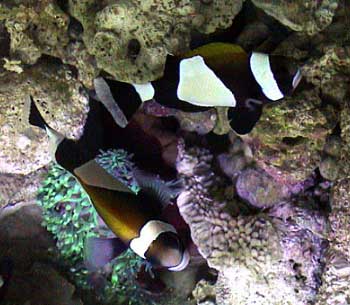 |
A rare clownfish, the Wide-band Clownfish, is seen here.
Amphiprion
latezonatus
reportedly does best in cooler aquariums.
Photo courtesy of
BonsaiNut.
Most readers are probably well aware of
the obligate symbiotic nature of anemonefish with hosting
anemones. This symbiotic relationship between the host anemone
and anemonefish is termed "mutualism" as both members
of the relationship benefit from the other partner. The single
most important benefit of anemones towards anemonefish is
protection. In the wild, clownfish are always located within
a host anemone. A wild clownfish not hosting within a sea
anemone is most often quickly consumed by any number of predators.
It is the nematocysts of the sea anemone that ward off the
attacks of groupers or other predators of anemonefish. Sea
anemones gain several benefits from the hosting fish. In some
areas, sea anemones will not survive without their host anemonefish.
Butterfly fish are quick to dine upon anemones without a symbiotic
partner standing guard. In some cases it has been noted that
anemones will be consumed in less than 24 hours after removal
of anemonefish (Fautin, 1986). In addition to protection,
clownfish will achieve several tasks just from normal swimming.
They will aerate the water around the tentacles, they will
remove waste from the oral disc, and finally they will provide
nitrogenous waste (food) to the host anemone. It is considered
folklore, by many researchers, that an anemonefish will capture
food items from the water column and "feed" the
anemone. This has been known to happen within the confines
of aquariums, but has not been witnessed by researchers in
the wild.
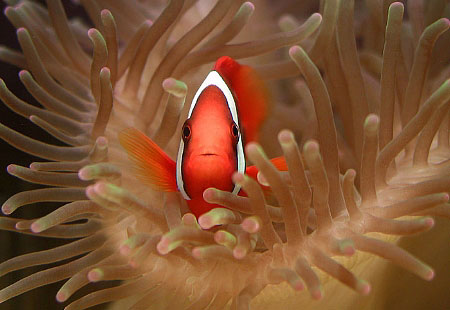 |
Clownfish, such as this unidentified member of the Tomato
complex, will vigorously defend
their host anemone. This one prepares to make a lunge at the
photographer if he gets too close.
Photo courtesy of Greg Rothschild of Mother
Nature's Creations.
Some readers, at this point, may be curious
why the nematocysts of the sea anemone can offer protection
to the anemonefish, and yet not harm the anemonefish. Quite
frankly, we still do not know, although several hypothesis
have been offered. Schlichter's hypothesis of camouflage
was the first one offered, and was generally accepted until
1980. Schlichter's decade long study concluded that anemonefish
will become coated with the mucus of the anemone by careful
acclimation into the host. The result was an anemonefish that
was "invisible" to the nematocysts. Opponents to
this hypothesis argue that the shred mucus was a result of
acclimation, not the explanation of how the mutualism can
take place. Then in 1980 Lubbock released his hypothesis
of inert mucus, which showed A. clarkii to have
predominantly neutral polysaccharides. These neutral polysaccharides
differ from that of the acidic mucus found on non-symbiotic
fishes. Additionally, they failed to induce a triggered response
from nematocysts, unlike the acidic mucus of the aforementioned
non-symbiotic fish. All was well with this theory and Lubbock
was a hero until he couldn't leave well enough alone. He took
his study one step further and discovered that A. clarkii
needed a four day acclimation upon leaving Stichodactyla
haddoni for Entacmaea quadricolor. Obviously, this
four day waiting period would not have been needed if the
mucus of the fish was truly inert. Hence was born the hypothesis
of thick mucus, which was rather short lived. It was believed
that a clownfish inhabiting a host would have a thicker mucus
coating which would in turn afford greater protection from
the deadly nematocysts. Lubbock, once again, discounted his
own hypothesis when he showed that the mucus coating of A.
clarkii not in a host anemone was the same as one that
was acclimated to a host anemone. Research continued until
Lubbock proposed his hypothesis of customized mucus chemistry,
which was based on the principle that a clownfish will reduce
the amalgamation of substances within its mucus which stimulate
nematocyst discharge. In 1984 the hypothesis of thick mucus
was revisited when Brooks and Mariscal tried to discount the
hypothesis of camouflage. Instead of discounting the work,
they assisted in the confusion. They showed a limited, albeit
shortened, acclimation period was required even when anemonefish
were previously acclimated to fake anemones created with rubber
bands and silicone. This required acclimation did not eliminate
the hypothesis of camouflage, revived discussion on
the hypothesis of thick mucus, and neither discounted
nor proved the hypothesis of customized mucus chemistry.
Confused yet? More recently, Miyagawa (1989) proposed the
hypothesis of innate protection. He demonstrated that
planktonic post larvae are stung when forced into contact
with a host anemone. However, juveniles 12 to 24 hours older
are not stung by the nematocysts. This 12 to 24 hour period
directly coincides with the period that juvenile anemonefish
institute a union with its preferred host anemone. Finally,
Elliot set his sights on this complex interrelation. In 1994
he attempted to solve the mystery surrounding the mucus of
the fish and anemone. What he found was that A. clarkii
does not produce or have similar mucus to that of its
host anemone, but it will collect the anemone mucus within
its own once contact has been made to the anemone and thereby
carry both the mucus of itself and the host anemone (Elliot,
1994). His 1997 work detailed how A. clarkii was innately
protected from host anemones, however, A. ocellaris
and A. perideraion are not (Elliot, 1997a). Furthermore,
he showed larvae of ten species of clownfish will all be captured
and consumed by the host anemones, but shortly after metamorphose
this did not occur to certain species (Elliot, 1997b). Despite
all of the research performed on this topic, no clear-cut
answer has yet been determined. It remains one of life's great
mysteries.
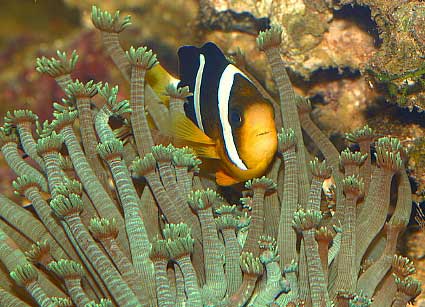 |
As should be evident from this photo and many others within
this column, Clownfish will
host in most any coral. This Amphiprion clarkii is
seen here hosting in a Goniopora sp.
Photo courtesy of Greg Rothschild.
Clownfish definitely have their preferences
of hosting anemones, though this preference is strangely not
adhered to in captivity nearly as strongly as in the wild.
Of the nearly 1,000 species of anemones, only ten species
from five genera are ever used as symbiotic hosts for clownfish.
The anemonefish and their known natural
symbiotic host anemones are detailed below with the anemone
at the top of the chart and all natural hosting anemonefish
below. It should be noted that A. clarkii is known
to naturally host with each known hosting anemone. It should
also be noted that in rare circumstances it has been noted
that anemonefish may host in large-polyped stony corals such
Euphyllia spp. or Goniopora spp. (Michael, Coral
Realm).
A beautiful, young, male Amphiprion frenatus hosting
in a Euphyllia sp.
Photo courtesy of Greg Rothschild.
Anemonefish and Their
Known Natural Symbiotic Host Anemones:
|
Entacmaea
quadricolor
|
A.
akindynos
|
A.
mccullochi
|
|
A.
allardi
|
A.
melanopus
|
|
A.
bicinctus
|
A.
omanensis
|
|
A.
chrysopterus
|
A.
rubrocinctus
|
|
A.
clarkii
|
A.
tricinctus
|
|
A.
ephippium
|
P.
biaculeatus
|
|
A.
frenatus
|
A.
latezonatus
|
|
Heteractis
crispa
|
A.
akallopisos
|
A.
melanopus
|
|
A.
bicinctus
|
A.
omanensis
|
|
A.
chrysopterus
|
A.
percula
|
|
A.
clarkii
|
A.
perideraion
|
|
A.
ephippium
|
A.
polymnus
|
|
A.
latezonatus
|
A.
sandaracinos
|
|
A.
leucokranos
|
A.
tricinctus
|
|
|
Cryptodendrum
adhaesivum
|
Heteractis
malu
|
|
Heteractis
magnifica
|
A.
akallopisos
|
A.
leucokranos
|
|
A.
akindynos
|
A.
melanopus
|
|
A.
bicinctus
|
A.
nigripes
|
|
A.
chrysogaster
|
A.
ocellaris
|
|
A.
chrysopterus
|
A.
percula
|
|
A.
clarkii
|
A.
perideraion
|
|
Heteractis
aurora*
|
A.
akindynos
|
A.
chrysopterus
|
|
A.
allardi
|
A.
clarkii
|
|
A.
bicinctus
|
A.
tricinctus
|
|
A.
chrysogaster
|
|
* Adult
clowns are not located in Heteractis aurora,
only juvenile clownfishes.
|
|
Stichodactyla
gigantea
|
A.
akindynos
|
A.
percula
|
|
A.
bicinctus
|
A.
perideraion
|
|
A.
clarkii
|
A.
rubrocinctus
|
|
A.
ocellaris
|
|
|
Stichodactyla
haddoni
|
A.
akindynos
|
A.
clarkii
|
|
A.
chrysogaster
|
A.
polymnus
|
|
A.
chrysopterus
|
A.
sebae
|
|
|
Macrodactyla
doreensis
|
A.
chrysogaster
|
A.
perideraion
|
|
A.
clarkii
|
A.
polymnus
|
|
Stichodactyla
mertensii
|
A.
akallopisos
|
A.
fuscocaudatus
|
|
A.
akindynos
|
A.
latifasciatus
|
|
A.
allardi
|
A.
leucokranos
|
|
A.
chrysogaster
|
A.
ocellaris
|
|
A.
chrysopterus
|
A.
sandaracinos
|
|
A.
clarkii
|
A.
tricinctus
|
The Pink Skunk Clownfish, Amphiprion perideraion, is
seen here in a photo from the wild.
Photo © Jeffrey Jeffords, Divegallery.com. Used with
permission.
At about this time I would expect the reader
to wonder how and why clownfish choose the anemone that they
do. Thankfully, you are not the only person that has ever
contemplated this. Arvedlund, et. al. (1999) found
that the eggs of the clownfish were imprinted with cues during
the development process. The eggs are laid nearby the base
of the host anemone of the parents, where the imprinting occurs.
Olfactory cues are imprinted according to the mucus released
from the oral disc and tentacles of the anemone. These olfactory
cues assist the juvenile clownfish in locating the same species
of anemone that its parents preferred. Arvedlund's work was
an extension of the work performed by Elliot in 1995 where
they concluded clownfish species were able to track the scents
of hosting anemones from as far away as 8m down current (Elliot,
1995).
All clownfish females are the result of
males undergoing a sex change, or protandric hermaphrodites
as they are called. In most host anemones a small harem of
clownfish are present. Generally, this harem contains a single
female, a single male, and several juvenile fish. The female
is the most dominant member of the harem, and her constant
attention to the harem ensures that the male does not develop
into a female. When the female becomes absent from the harem,
the male will assume the role of the female. Once a female,
the fish cannot revert back to male. Both the male and female
inhibit the sex change tendency of the juveniles. This phenomenon
is often referred to as "psychophysical castration."
When the male undergoes sex change and becomes a female, the
juveniles will battle to determine who the most dominant member
is. The winner will then grow testicles and become a male.
These sex changes will occur in less than one month. In some
instances, immigrating fish may disrupt this natural hierarchy.
Some species (A. clarkii) have been noted to roam over
500 feet in search of another host anemone. In these cases,
males and females may get thrown out of their host anemone
by a stronger individual that left their original host anemone.
Generally, these migrating specimens were displaced from their
previous anemone in similar fashion. Juveniles will also migrate
to nearby host anemones in hopes of moving up in the pecking
order. In rare situations, juveniles may skip over the step
of becoming a male, instead maturing from a juvenile into
a female. This may occur if a male and female are not present
in the host anemone, or a roaming juvenile is more dominant
than the present female and male.
In most species of clownfish sexual dimorphism
is present with the female being the larger of the two sexes.
This is most pronounced in Premnas biaculeatus where
the male is usually 30% of the size of the female. Although
noted in Amphiprion clarkii and A. frenatus,
sexual dichromatism is considered rare.
In the Home Aquarium
The majority of clownfish can be kept in
home aquariums rather successfully, with several accounts
of clownfish surviving for over 20 years. As with any marine
fish, certain parameters must be met to ensure a happy, healthy
fish. Similar to all the other fish I have covered in this
column, pristine water parameters are assumed to be in place
prior to introduction of the inhabitants. If optimum conditions
are not yet present, this is obviously the first area of concern.
For the purpose of this column, "optimum" should
mirror natural sea water as closely as possible.
Once water parameters are under control
the hobbyist needs to choose a clownfish and determine if
it will require an aquarium to itself. Some species, like
Premnas biaculeatus, are extremely aggressive fish.
Juveniles can coexist with other fish, but as they age, their
temperament will change as well. Adults of this species generally
prefer an aquarium to themselves. Do not be surprised if Premnas
biaculeatus decides to kill its tankmates, preferring
to create a species aquarium for herself (and her mate). Despite
Premnas biaculeatus gaining the reputation as the "meanest"
clownfish, all clownfish are aggressive to some degree or
another. Remember, they are damselfish after all. All clownfish
will aggressively defend their host and a territory surrounding
the host. Assuming you choose a clownfish other than P.
biaculeatus, there are some fish that need to be avoided
in their aquarium. Basically, any large predators, such as
groupers or lionfish, need to be avoided. For these fish a
clownfish represents an easy meal. Triggerfish or moray eels
should also be added to this list. For a complete list, see
below. Please note the list is specifically for Amphiprion
species, as Premnas biaculeatus usually requires a
tank to itself. However, this does not mean P. biaculeatus
can be housed with predatory fish. They will likely either
become food for the predators, or kill them in self-defense.
Lastly, it is very important to note that for all species
of clownfish the corallimorpharian commonly referred to as
the elephant ear anemone, Amplexidiscus fenestrafer,
will consume the clownfish. Do not place this anemone into
any aquarium containing clownfish.
Compatibility
chart for Amphiprioninae:
|
Fish
|
Will Co-Exist
|
May Co-Exist
|
Will Not Co-Exist
|
Notes
|
|
Angels, Dwarf
|
X
|
|
|
Should be excellent tankmates.
|
|
Angels, Large
|
|
X
|
|
Large Angels may become territorial.
|
|
Anthias
|
X
|
|
|
Should be excellent tankmates.
|
|
Assessors
|
X
|
|
|
Should be excellent tankmates.
|
|
Basses
|
|
|
X
|
Adults may consume clownfish.
|
|
Batfish
|
X
|
|
|
Should be excellent tankmates.
|
|
Blennies
|
X
|
|
|
Should be excellent tankmates.
|
|
Boxfishes
|
X
|
|
|
Should be excellent tankmates.
|
|
Butterflies
|
X
|
|
|
Should be excellent tankmates.
|
|
Cardinals
|
X
|
|
|
Should be excellent tankmates.
|
|
Catfish
|
|
|
X
|
Adults may consume clownfish.
|
|
Comet
|
X
|
|
|
Should be excellent tankmates.
|
|
Cowfish
|
X
|
|
|
Should be excellent tankmates.
|
|
Damsels
|
|
X
|
|
Best avoided except for large aquariums.
|
|
Dottybacks
|
|
X
|
|
Some dottybacks are very aggressive and are best housed
by themselves.
|
|
Dragonets
|
X
|
|
|
Should be excellent tankmates.
|
|
Drums
|
|
X
|
|
Drums can become aggressive. Clownfish in first.
|
|
Eels
|
|
X
|
|
Some eels become large enough to consume clownfish.
|
|
Filefish
|
X
|
|
|
Should be excellent tankmates.
|
|
Frogfish
|
|
|
X
|
Adults may consume clownfish.
|
|
Goatfish
|
X
|
|
|
Should be excellent tankmates.
|
|
Gobies
|
X
|
|
|
Should be excellent tankmates.
|
|
Grammas
|
X
|
|
|
Should be excellent tankmates.
|
|
Groupers
|
|
|
X
|
Adults may consume clownfish.
|
|
Hamlets
|
X
|
|
|
Should be excellent tankmates.
|
|
Hawkfish
|
|
X
|
|
Large hawkfish may consume clownfish.
|
|
Jawfish
|
X
|
|
|
Should be excellent tankmates.
|
|
Lionfish
|
|
|
X
|
Adults may consume clownfish.
|
|
Parrotfish
|
X
|
|
|
Should be excellent tankmates.
|
|
Pineapple Fish
|
X
|
|
|
Should be excellent tankmates.
|
|
Pipefish
|
|
|
X
|
Pipefish are best housed by themselves.
|
|
Puffers
|
|
X
|
|
Some puffers can become aggressive. Clownfish in first..
|
|
Rabbitfish
|
X
|
|
|
Should be excellent tankmates.
|
|
Sand Perches
|
|
X
|
|
Sand perches can become incredibly aggressive. Clownfish
in first.
|
|
Scorpionfish
|
|
|
X
|
Adults may consume clownfish.
|
|
Seahorses
|
|
|
X
|
Seahorses are best housed by themselves.
|
|
Snappers
|
|
|
X
|
Adults may consume clownfish.
|
|
Soapfishes
|
|
|
X
|
Adults may consume clownfish.
|
|
Soldierfish
|
|
|
X
|
Adults may consume clownfish.
|
|
Spinecheeks
|
X
|
|
|
Should be excellent tankmates.
|
|
Squirrelfish
|
|
|
X
|
Adults may consume clownfish.
|
|
Surgeonfish
|
X
|
|
|
Should be excellent tankmates.
|
|
Sweetlips
|
|
|
X
|
Adults may consume clownfish.
|
|
Tilefish
|
X
|
|
|
Should be excellent tankmates.
|
|
Toadfish
|
|
|
X
|
Adults may consume clownfish.
|
|
Triggerfish
|
|
X
|
|
Some triggerfish are incredibly aggressive. Clownfish
in first.
|
|
Waspfish
|
|
|
X
|
Adults may consume clownfish.
|
|
Wrasses
|
X
|
|
|
Should be excellent tankmates.
|
Note: While many of the fish listed are
good tank mates for Amphiprion
spp., you should research each fish individually
before adding it to your aquarium. Some of the fish mentioned
are better left in the ocean, or for advanced aquarists.
As with all marine fish, ensuring they
receive the proper amounts and type of food is of paramount
importance. Clownfish are omnivores, consuming small amounts
of red filamentous or blue green algae, though for the most
part they consume plankton from the water column. Although
the largest portion of their diet is comprised of copepods,
food items such as tunicate larvae, echiuroid worms, sipunculid
worms, polychaetes, nematodes, barnacle cirri and nauplii,
amphipods, isopods, ostracodes among other things (Michael,
Coral
Realm). In addition to the above mentioned food items,
anemonefish will feed upon their hosts. Anemone tentacles
have been found in the stomach contents of anemonefish (more
on this later). Essentially, their feeding regimen is ideal
for marine fish kept in captivity as it makes feeding them
a rather easy chore. Any of the meat based prepared foods
on the market today should suffice well. Plankton, mysids,
and enriched brine shrimp are all good foods to feed in any
of the formats they can be found in: freeze dried, live, or
flash frozen. Flake or pellet foods geared for the marine
carnivore will also be an excellent staple food. Offering
a variety of foods is a good idea, so do not become stuck
in the rut of feeding the same foods every day. Generally,
clownfish will accept any of these foods without hesitation
even after recently being added to the aquarium. For finicky
fish that refuse to feed, try to obtain live foods. It is
rather doubtful that a clownfish can resist live adult brine
shrimp or any small mobile planktonic crustacean.
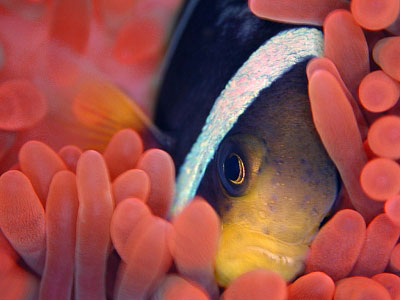 |
This clownfish, an Amphiprion clarkii, keeps an eye
out for his next meal
from the safety of his beautiful Rose anemone, Entacmaea
quadricolor.
Photo courtesy of Robie Sayan.
Diseases and parasites in clownfish can
be, unfortunately, a common occurrence. This may be their
only downfall as an aquarium fish. They seem to be susceptible
to almost all marine diseases and parasites. Some of the more
common parasites associated with clownfish are Cryptocaryon
irritans and Brooklynella hostilis. The former
generally can be associated with all species of clownfish,
while the latter generally only affects Premnas biaculeatus.
The best and possibly easiest method of curing your clownfish
from Cryptocaryon irritans, as with all marine diseases
and parasites, is utilizing a hospital tank; an aquarium setup
for the sole purpose of medicating the inhabitants. In the
case of Cryptocaryon irritans a lowered salinity of
1.010 - 1.011 works best. You will need to leave your clownfish
in this lowered salinity for a period of no less than seven
days. Brooklynella hostilis is another easily-countered
parasite. A simple 15 minute freshwater dip generally eliminates
this parasite. The final external parasite to be concerned
with is known as Amyloodinium ocellatum. Unfortunately,
this parasite is considerably destructive and treatment is
a crapshoot at best. In most situations, the hobbyist will
not realize something is amiss until their fish start dieing.
At this point, treatment is probably too late. In the rare
situations that this parasite is caught in time, the most
effective treatment is copper followed by a day of lowered
salinity. The lowered salinity does not kill the parasite,
but it will cause it to fall off of its host, thus relieving
some of the stress caused by the parasite. Follow up with
copper treatment after slowly raising the salinity to a more
comfortable level of 1.018 - 1.020. Some clownfishes, especially
Premnas biaculeatus, have a difficult time with copper
treatments. Therefore, copper treatments should be monitored
closely. A copper level of .20 mg/L should be enough to assist
in eradicating the parasite, but at the same time will likely
not cause harm to your clownfish. The easiest way to eliminate
the spread of this parasite is to place your new arrivals
into a quarantine tank for at least one month. Severe infestations
may require the complete draining of the aquarium and allowing
it to become completely dry for several days. It should be
noted that captive-bred clownfish are considered to be completely
free of this parasite - reason enough to purchase captive-bred
animals. As is usually the case, the aforementioned parasites
often lead to further complications. The fungal disease commonly
referred to as "popeye" is an opportunistic disease
usually preying upon weakened fish. If pristine water parameters
are maintained and the parasites are eliminated, popeye will
often heal by itself with no assistance from the aquarist.
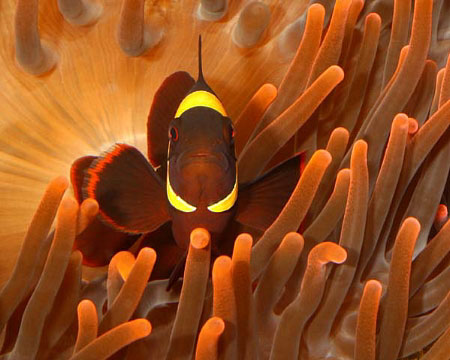 |
A Gold Striped Maroon Clownfish, Premnas biaculeatus,
poses for our viewing pleasure.
It’s only natural host, the magnificent Entacmaea
quadricolor, is seen in the background.
Photo courtesy of Greg Rothschild of Mother
Nature's Creations.
Do clownfish require an anemone in the
home aquarium? In a word, no. All clownfish will live out
a normal, happy life without ever laying eyes on an anemone
in the aquarium. In fact, in the home aquarium some clownfish
have been known to smother the anemone to death (Shimek, 2001).
This is likely the result of large clownfish essentially loving
their smaller host anemone to death. In the home aquarium
where water parameters are often less than ideal for host
anemones, this seems like it is often the final straw that
leads to the untimely death of the anemone. The main reason
why clownfish utilize a host anemone is for protection. Hopefully,
this protection is not needed in your aquarium. It shouldn't
be needed if you designed the aquarium properly with the clownfish
in mind. However, for most hobbyists the beauty of clownfish
is not complete without them swimming amongst a host. In these
situations, any number of animals can be used as a host. Clownfish
will host in most any coral when anemones are not present;
from leather corals, to zoanthids, and my personal favorite,
LPS corals. It should also be noted that clownfish do not
necessarily need a coral to host in, either. Clay flowerpots
cut in half are often an irresistible host for newly introduced
clownfish.
Still can't resist the desire to witness
and observe the natural symbiotic relationship of an anemone
and an anemonefish in your own aquarium? This seems too great
of a temptation for most to resist. If this is the case, first
and foremost the hobbyist must become educated on anemones.
Anemones do not have a marvelous track record in home aquariums.
Most perish in under a year within the confines of the home
aquarium. The care of an anemone in the home aquarium is a
discussion too great to concern ourselves with in this column,
and thus I will not go into the particulars. Previous works
on the care of anemones have already been detailed. Therefore,
I will simply direct you to a couple of links that have superb
information on this topic. Both links are authored by Dr.
Ronald L. Shimek. The first
link offers detailed descriptions on anemones as a whole,
and the second
link concerns primarily the host anemones. Please do take
a moment to read these columns.
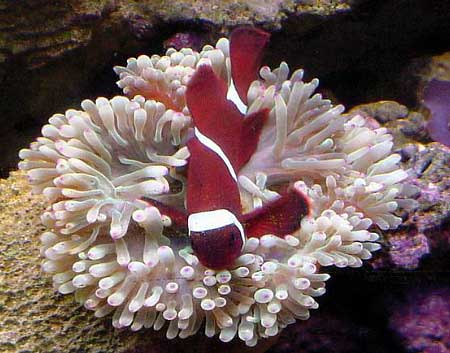 |
A White Striped Maroon Clownfish, Premnas biaculeatus
is seen here settling into its host.
Photo courtesy of Keith Douglas.
Finally, what discussion on fish would
be complete without taking a moment to confer on aquarium
size? The size of the aquarium depends upon tankmates for
the most part. A pair of clowns by themselves need only a
standard 40 gallon "breeder" aquarium (36"
x 18" x 18"), though commercial breeding facilities
usually use a 20 gallon aquarium. Depending on the size and
number of fish you wish to keep with the clownfish, the aquarium
size will need to be increased. Also, the amount of the increase
will depend on the territory requirements of the additional
fish you wish to add. As mentioned earlier, clownfish aggressively
defend their territory. An aquarium of limited size containing
a hosting pair of clownfish will not afford much swimming
space to tankmates.
Captive Breeding
As most hobbyists are probably well aware
of already, captive breeding of clownfish can be termed "highly
successful." In fact, I encourage those individuals looking
into purchasing clownfish to consider nothing but captive-bred
fish. They are often a healthier alternative to their wild
counterparts. In addition, all (according to Fautin) anemones
left without a clownfish defending it, due to collection of
the clownfish, will often succumb to the attacks of butterfly
fish or hawksbill turtles. This will also result in the death
of the numerous other symbionts (crabs, shrimps, and other
fishes (such as domino or three-spot damsel fish) living on
the same anemone.
For many hobbyists with a pair of clownfish,
witnessing your pair breed is a likely occurrence. If you
are like the many hobbyists before you, you will in due time
try your hand at raising the fry. Although I cannot term this
endeavor as being "easy," it can be done.
A spawning pair of Amphiprion ocellaris is seen here
guarding their eggs.
Photo courtesy of Manderx.
The whole process will begin with the courtship.
Males will begin biting at the substrate and will increase
the frequency of this action the closer the mating comes to
fruition. This will usually begin three to five days prior
to the actual mating ceremony. As the day approaches, the
female will join the male in substrate biting. During the
final day the pair will become noticeably more aggressive,
actively chasing away any fish that come nearby. After a brief
courtship, which will include various forms of posturing,
the female will lay her eggs upon a flat surface just off
the side of their host anemone in the area that was cleared
of debris earlier. In species of anemones that set their foot
in soft sand substrates, the adult clownfish will hunt for
a flat substrate surface to work with. Such items as shells,
sand dollars, coconut shells, or most any human litter such
as tin cans or plastic have been used. Just prior to sun up
the pair will nip at the tentacle of its host causing it to
retract in the area where the eggs will be laid. The female
will make a few practice attempts at egg laying, then finally
as morning begins to take shape, the female will rest her
swollen abdomen against the intended nesting site and drag
herself, using her pectoral fin, around the site simultaneously
releasing the unfertilized, sticky, negatively buoyant eggs.
The male swims closely behind the female, fertilizing the
eggs as he follows. The actual egg laying will take on average
two hours. For a pictorial featuring many of these spawning
events, click here.
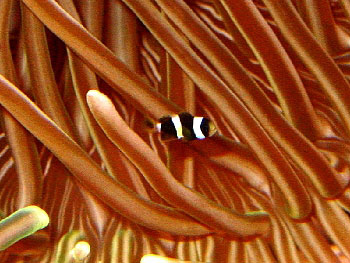 |
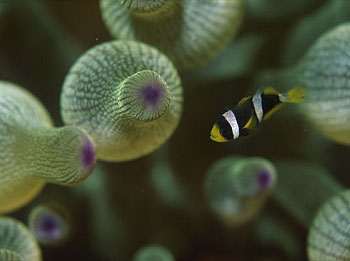 |
Juvenile Amphiprion clarkii clownfish already acclimated
to their hosting anemones.
Photo courtesy of Mona Liu (left) and Jun Harada (right).
With the easy part out of the way, the
pair must now defend the eggs from potential predators. The
female moves away from the nest and usually goes directly
into feeding mode, while the male jumps into action and now
belligerently defends and diligently tends to the nest. Any
approaching predators are quickly attacked by the male who
prefers to rely on an excellent offense as his best defense.
That is, without hesitation, he will begin attacking and biting
the on-comer. When there is no threat present, the male will
fan the eggs with his tail to both aerate the eggs as well
as removed any debris that may have settled onto the eggs.
Though the female will assist the male on occasion, this is
not considered to be common practice. In addition to fanning
the eggs, the male will remove any unfertilized or fungally-infected
eggs by consuming them. Depending on factors ranging from
female size to individual species, the eggs will number between
100 and 2,500 eggs. The color of the eggs will take on several
different variations as they mature. Generally, eggs are pink
to orange in color as they are laid and remain so for a couple
days. As the eggs age the pink to orange will gradually fade
into a drab grey or brown color. Finally, as the hatching
nears, the eggs will become shiny sliver with the developed
eyeballs of the fry clearly visible. Depending on which species
are involved and the water temperatures present at the nesting
site, the eggs will hatch around day seven or shortly thereafter.
The eggs hatch as swimming larvae and under the protection
of night they join the tumultuous life of plankton. If the
larvae win the equivalent of the clownfish lottery and survive,
the larvae will settle out in from 8 to 16 days.
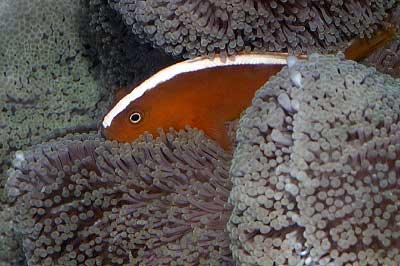 |
The Orange Skunk Clownfish, Amphiprion sandaracinos,
tucked in tight to
its carpet anemone. They are a great choice for the beginner
aquarist but not for
the beginning clownfish breeder. Photo courtesy of Greg Rothschild.
Life does not get any easier for larvae
in the wild at this point. As the larvae begin to settle out
they must find a suitable host anemone before they become
food. As is most often the case they do not find a host, but
in rare occasions the young clownfish are able to locate a
host using their olfactory clues imprinted upon their eggs
during development. Once they find the anemone, they will
have to make one last fight for life before their odds of
survival improve. Somehow, they must fight conspecifics for
a spot on the bottom of the totem pole. Again, if they are
not allowed to join the hierarchy of clownfish present, it
must either continue searching for another suitable host or
become dinner. Once the young clownfish prove their worth
and are accepted into a host anemone, odds on survival greatly
improve.
Luckily for the larvae, life isn't so challenging
when spawned in captive conditions. Perhaps these captive-bred
clownfish are the true winners of the clownfish lottery, as
the odds are considerably better for survival than their wild
counterparts. Of course, the final odds depend directly upon
you, the caretaker, and your abilities as an aquarist. After
successive hatches, you will develop excellent techniques
of your own until the odds of survival are stacked in the
clownfishes favor.
|
|
The reader can clearly see the development of the
fry after hatching in this series of photos.
At day 6 the fry are already starting to develop.
By day 11 the fry already begin to look somewhat orange,
and by day 14 they are virtually miniature versions
of their adult parents.
Photos courtesy of Bob Schulz.
|
Going into great detail on the rearing
of clownfish fry is outside the scope of this column. If done
correctly, it would likely require several columns unto itself.
With this in mind, I will offer a very basic guide on what
is required for successful rearing of fry. Please use this
only as a starting point. For a more detailed account, please
try and acquire the reference book by Wilkerson (2001), as
noted in the reference section below.
Clownfish larvae left in the aquarium with
their parents will likely be consumed by the parents. As such,
removal of the larvae is essential. The easiest way to go
about this is to remove the fry just prior to hatching. Since
the eggs are attached to a flattened stone, it may be easiest
if you provide this stone for your fish. Shells, ceramic tiles
or the bottom of clay pots work excellent in this regard.
Once removed, place the stone into its own aquarium. Water
movement over the eggs is vital to the well-being of the eggs.
A properly placed air stone should suffice nicely. Ensure
the air stone is supplying ample water agitation around the
eggs.
Prior to the eggs hatching you must make
certain that food will be readily available to the larvae.
At the time the larvae hatch their overall size will dictate
the need to feed them live foods called rotifers. It is likely
that the aquarist will need to grow their own live foods unless
your local stores are doing this and selling it retail, which
is doubtful. For extensive information regarding the culturing
of rotifers, check here.
Of course, rotifers will require food themselves, so that
they are nutritious. Phytoplankton is best used to fill this
need and it is rather easily cultured. For extensive information
on culturing live phytoplankton, check here.
Live phytoplankton can also be purchased from local or online
sources, though it may be more economically viable to culture
it yourself. You can expect the need to feed live rotifers,
and thus culture live rotifers and phytoplankton, to continue
for as short as seven days and up to fourteen days, depending
on the size of the larvae. This is actually when the larvae
metamorphose, and thus are capable of consuming live nauplii.
Once again, the home aquarist will have to culture this live
food. Explore this week's specials with
Lidl Offers!
For extensive information on culturing live brine shrimp,
check here.
By day 15, or possibly sooner, you should make an attempt
at transferring the clownfish from live foods to pulverized
dry foods with anticipation of feeding exclusively pulverized
dry food by day 25 to 30. The food is pulverized so it is
small enough to be consumed by the small fish.
|
In this series of photos the reader can clearly see
the development of the fry, from the early stages when
they are first laid by the female, to the silver encased
eyeballs ready to hatch, and moments after hatching.
Photos courtesy of Bob Schulz.
|
|
There are three main areas that contribute
to the most losses of larvae and juvenile clownfish, and for
the most part they can be controlled by the aquarist. Supplying
enough food is usually the largest hurdle to overcome. Sometimes,
however, the food is available but the larvae and fry are
unable to capture it. Water quality can be just as important.
Due to the heavy feeding regimen, daily water changes must
be performed. If not, the water quality will suffer and you
will experience fish losses. Water changes upwards of 50 -
75% daily are recommended. Make-up water should be taken from
the show aquarium, and thus freshly mixed salt water replaced
into the show aquarium. This will allow for larger water change
percentages while still maintaining stable water parameters.
The last area that usually claims a large percentage of deaths
is obviously the metamorphosis. However, this can be tied
together with the two previous causes of demise because the
lack of high quality food and sub-par water quality will have
a direct influence on how well the larvae are able to cope
with metamorphosis. If the hobbyist can avoid these three
common mistakes, it is likely that you will have good success.
Meet the Species
Of the 28 described species of clownfish,
only about 20 are available for purchase in the hobby with
any regularity. Even so, the number is probably closer to
ten species that should be considered commonly available.
For the purpose of this column, I'll discuss the species within
their complexes.
A pair of Amphiprion ocellaris in the home aquarium.
Photo courtesy of Greg Rothschild.
A gorgeously colored Amphiprion percula clownfish in
the home aquarium.
They are poor swimmers and rarely move outside the safety
of their host anemone.
Photo courtesy of Greg Rothschild.
This mated pair of Amphiprion ocellaris, the False
Percula, have bred many times in the editor's aquarium.
They are seen here with their host, a Long-tentacle anemone.
Photos courtesy of Skip Attix.
By far the most popular clownfish are those
from the Percula complex. Amphiprion ocellaris, or
the Ocellaris aka False Percula Clownfish, is nearly identical
in almost every aspect to its close cousin, A. percula,
or the Percula Clownfish. They are the smallest of clownfish,
not quite reaching three inches of total length. Both can
be fairly timid as young individuals, but as they grow into
an aquarium, they will aggressively defend their limited territory.
The amount of territory they claim is among the smallest of
all clownfish, likely due to the fact they are very poor swimmers.
If a hobbyist wishes to maintain a small harem of clownfish,
A. ocellaris is your best option. Members of this complex
have been known to spawn in aquariums as small as 10 gallons.
The nervous Pink Skunk Clownfish, Amphiprion perideraion,
is a difficult
species for clownfish breeders to successfully spawn.
Photo courtesy of Greg Rothschild.
From the Skunk complex come Amphiprion
akallopisos, A. perideraion, and A. sandaracinos,
amongst others. Like the Percula complex, all of these species
are similar to each other in care. They will defend their
territory, but rarely settle into an aquarium if aggressive
fish are already present. As such, these clownfish should
be amongst the first fish into an aquarium. Again, similar
to the Percula complex, these fish are hardy aquarium fish.
However, they are difficult to get to spawn.
Amphriprion frenatus hosting in a beautiful Rose anemone.
Photo courtesy of Greg Rothschild.
The clownfish from the Tomato complex form
another staple of the hobby, and therefore can usually be
located in most aquarium stores worldwide. These fish are
generally hardy and aggressive, even to conspecifics. Therefore,
do not keep more than two specimens in the same aquarium.
Adults can reach up to four inches, though males are often
roughly half the size of their female companion. The two most
commonly available species from this complex are Amphiprion
melanopus, the Cinnamon Clownfish, and the namesake of
the complex, A. frenatus, also called the Tomato clownfish.
Species within this complex are regarded as among the easier
species to spawn and raise in captivity. Juveniles will often
have up to three vertical white stripes, but eventually two
of them fade to leave only a single white stripe just behind
the eyes.
Amphiprion frenatus, the Tomato Clownfish, sporting
the usual dark colored sides
and flame colored fins. Photo courtesy of Greg Rothschild.
A fantastic photo of Amphiprion melanopus, also called
the Red and Black
Clownfish. This is the Fiji color variant which lacks the
typical dark sides.
Photo courtesy of Greg Rothschild.
Members of the Clarkii complex are fast
growers and both male and female can reach four to five inches
of total length. Since they do host in all ten of the natural
hosting anemones, this complex is more geographically widespread
than any of their cousins. Coloration amongst the complex
is fairly similar with two vertical white stripes, one just
behind the eye and the second stripe occurring in the center
of the body. A third area of white is often located at the
base of the tail, though oftentimes it never fully develops
into a complete white band. Clarkiis are hardy aquarium fish,
and spawn regularly with large egg masses, up to 1,500 eggs
per spawn. They are the fastest swimming clownfish, most likely
due to their forked tail, which is not present on other clownfish.
Most likely due to the relative ease of swimming, they are
known for wandering farther away from their host than any
of the other species. The relative ease to spawn, overall
number of eggs, fast growing nature, and willingness to eat
anything they can as larvae and fry combines to make members
of this complex the best possible candidate for first time
clownfish spawners. The most popular of the complex is Amphiprion
clarkii, and generally it is available as both a wild
captured and captive-bred fish.
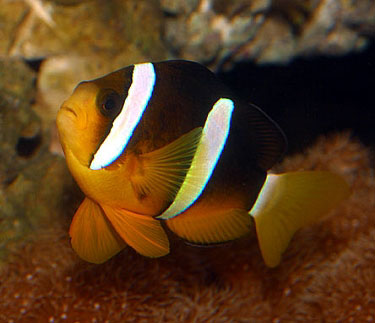 |
Amphiprion clarkii seen here in a home aquarium.
Photo courtesy of Greg Rothschild.
The most often mislabeled clownfish, the
Sebae, Amphiprion sebae, is a member of the Saddleback
complex. In addition, the very first clownfish ever discovered,
A. polymnus, is the namesake of the complex as it is
commonly referred to as the Saddleback clownfish. This complex
is characterized of rare, highly sought after clownfish that
have a difficult time adjusting to aquarium life. They are
noted as being self-destructive whenever they become frightened.
They are a large fish for clowns, maxing out around five inches
of total length. Members of this complex are often confused
with members of the Clarkii complex. The backward slope of
the second white stripe is the most distinguishing feature
separating the two complexes.
|
Right:
A perfect example of Amphiprion polymnus,
the Saddleback Clownfish. For the aquarist, this is
a
difficult species to locate as well as maintain. Photo
courtesy of Greg Rothschild.
|
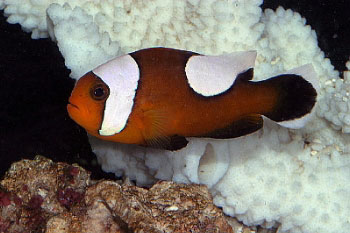 |
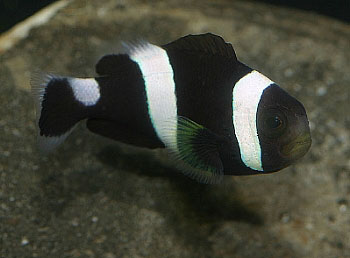 |
Left:
An unusual and highly sought after dark color
variant of Amphiprion polymnus. These are
often labeled in the stores as a Black Percula.
Photo courtesy of Greg Rothschild.
|
The final clownfish to discuss is the Maroon,
Premnas biaculeatus. Members of this species are noted
as being highly territorial. One of the trademark displays
of Maroon Clownfish (and other highly territorial clownfish)
is the tail-beating of the female as she attempts to procure
a suitable nesting area. For detailed photos and descriptions,
please take a moment to view this month's edition of ReefSlides.
Juveniles can coexist with larger fish and may even be picked
on, but as their size increases upwards of five to six inches,
the largest of all clownfish, their temperament grows with
them. In fact, their temperament is so aggressive that it
is difficult to pair up this species. Care must be taken when
introducing a male and female Maroon as the female is likely
to kill the incoming male. The best way to introduce these
beauties to one another is by utilizing fluorescent lighting
egg crate to separate the two fish. The male should be able
to swim in between the holes, while the female cannot. This
affords the male an escape hatch, which will likely be put
to use regularly. Males will grow in relation to the female
and will average roughly 30 - 40% of the size of females.
Two separate color varieties exist, appropriately named the
white striped and yellow striped Maroon, respectively. As
the name indicates, the difference lies solely in the color
of their striping. The yellow striped variety is a classic
representation of geographical variety - they are known to
hail only from Sumatra. This unique coloration affords them
the label of the most sought after Maroons.
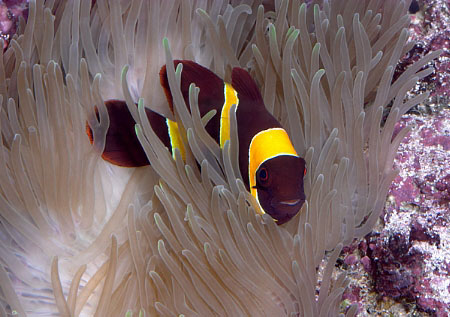 |
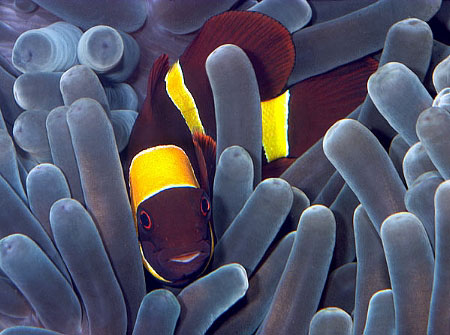 |
The gold stripes are rather apparent on this Gold Striped
Maroon Clownfish,
aka Premnas biaculeatus. Photos by Greg Rothschild.
(Left) A juvenile female Gold Striped Maroon Clownfish.
Note how the gold has yet to materialize on the juvenile.
As she ages the gold will fill in. (Right) Nine months
later the same female and her mate in a new host. Note how
the female is starting to develop a slight Gold coloration
in her stripes. Photos by Henry C. Schultz III.
Conclusion
The adorable, wiggly fish known as Clownfish
are extremely recognizable in, and out of, the marine aquarium
hobby. With little effort, a pair of clownfish can be successful
kept, and even bred in our reef aquariums. However, these
cute fish are not exactly cuddly - they can be very aggressive
towards their fellow tankmates. Taking care in the selection
of the clownfish and their tankmates will oftentimes yield
desired results. Leaping haphazardly into their care will
just as often result in failure. Take the extra steps required
and purchase a captive-bred animal, which generally results
in a healthier fish, and one already accustomed to captive
life and foods.
|

